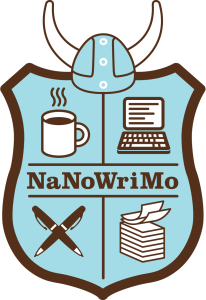
You’ve always been an avid reader and every once and a while you come across a book that makes you think “I can do better than that!” You’ve toyed with the thought of writing your own book many times, but always brushed the idea aside. I have good news for you. Have you heard of NaNoWriMo?
What is it?
NaNoWriMo stands for National Novel Writing Month. The goal is to start writing the first 50,000 words of your novel in the month of November. In this post I’ll share the basics of how NaNoWriMo works and a bit of my own experience of writing my 50,000 words of my first book.
Getting Started
I wrote this blog post a month early so you have some time to prepare if you want to participate. Use this month to think about what kind of novel you want to write, brainstorm some plot ideas on paper, and you may even prepare an outline. Also, create a NaNoWriMo account and read over the tutorials, FAQs, and read and post on the forums. You can actually link up with fellow writers in your area and even meet up for a “write-in” at a coffee shop or a book store.
For me, this is how my first novel, The Heidelberg Ghost, was born. We were stationed in Germany at the time, and I couldn’t find a book that I was interested in enough to read. One day, I brought a notepad and a pen with me to lunch, and I started jotting down some story ideas, something like a mischieveous ghost at the Heidelberg castle and it had to be a love story. So when I researched writing novels on the internet, I found out that NaNoWriMo was right around the corner. My mind was made up and I decided to join the challenge to write my book. I was motivated, to say the least.
November – The Month of (Intense) Writing
On November 1st, it’s game on. It’s butt glued to the chair and hands tied to the keyboard. To write 50,000 words a month, you have to pace yourself. This means 1,700ish words a day for some, or 1,000 words a day during the work week and then make up for the rest on the weekend. The key is not too get behind, especially since Thanksgiving will be towards the end of the month.
I chose to spread my word quota evenly across every day of the month. I would come home from work, cook dinner for the family, and sat down for 3-4 hours each night to hit my word count. I had prepared a good outline, so I had a fairly good rhythm when transitioning from scene to scene. That doesn’t mean it was easy, but I became quite fond of my characters, and I was looking forward to dive back into my story each night.
Here are some tips I learned the hard way:
- Refrain from re-reading or editing your work while you’re in writing mode. Your 1st draft will always be crap (so true, and even bestseller authors will tell you that). Just get your book written and only afterwards worry about editing, filling plot holes, and polishing it.
- Create a writing routine. Writing after dinner was perfect for me. I turned on some film-score music, which got my creative juices flowing. A nice hot cup of tea or hot chocolate won’t hurt, either.
- Stay on track. Try to at least knock out your minimum word count for the day. NaNoWriMo has a wonderful tracker that’ll graph your progress and calculates your daily minimum word count to complete your 50,000 words on time. Don’t forget to calculate in the time you’ll miss for Thanksgiving.
- Don’t worry if you have questions, worries, or if you’re freaked out about this whole process. You will have plenty of support from other writers that have joined the challenge.
I’m Done – What now?
First of all – congratulations on writing your first novel, or at least a good part of it. If you were able to write 50,000 words in November, you’re a NaNoWriMo winner. As a reward for your hard work, some vendors usually offer perks to winners, such as a steep discount on Scrivener software, an awesome writing program, which I still use today.
The next step is to finish your 1st draft, if you’re not already done with your entire book. It took me another 6,000 words until the “THE END”, so my 1st draft was about 56,000 words. Once it’s finished, let your manuscript rest for a few weeks. In my case, we moved back to the U.S. in February, and I didn’t start reading my manuscript, with red pen in hand, until April. I have to say, I was pleasantly surprised to read my own writing. It seemed surreal – more like I was reading someone else’s book.
Next, I did a few more editing rounds, before I sent my manuscript to a professional editor. I was shocked how much red was still on the pages when I got it back, but these were mostly suggestions to polish the manuscript. Finally, I was ready for a cover and to publish my now 75,000 word novel. I’ll be glad to share more about that process in future posts if you’re interested.
Leave a comment below if you’re planning to participate in NaNoWriMo 2017. I’m also happy to answer any questions you might have. Happy writing!!!

